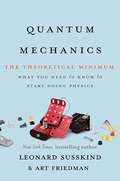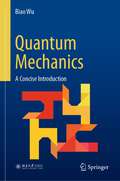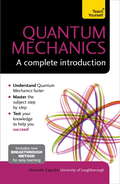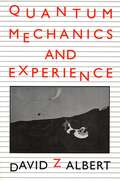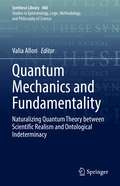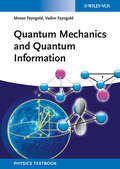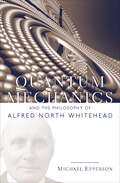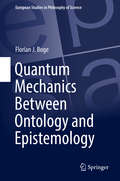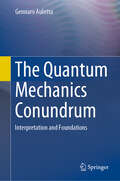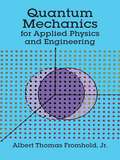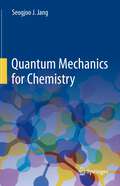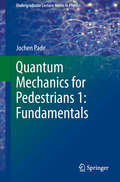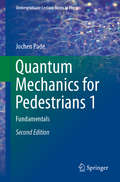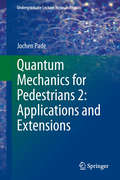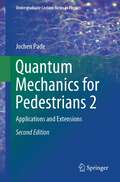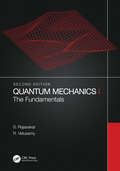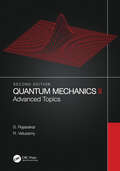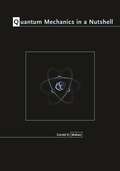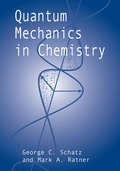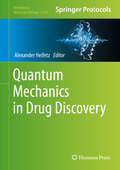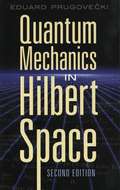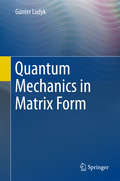- Table View
- List View
Quantum Mechanics: The Theoretical Minimum (The Theoretical Minimum)
by Leonard Susskind Art FriedmanFrom the bestselling author of The Theoretical Minimum, an accessible introduction to the math and science of quantum mechanicsQuantum Mechanics is a (second) book for anyone who wants to learn how to think like a physicist. In this follow-up to the bestselling The Theoretical Minimum, physicist Leonard Susskind and data engineer Art Friedman offer a first course in the theory and associated mathematics of the strange world of quantum mechanics. Quantum Mechanics presents Susskind and Friedman's crystal-clear explanations of the principles of quantum states, uncertainty and time dependence, entanglement, and particle and wave states, among other topics. An accessible but rigorous introduction to a famously difficult topic, Quantum Mechanics provides a tool kit for amateur scientists to learn physics at their own pace.
Quantum Mechanics: A Concise Introduction
by Biao WuThis textbook highlights a concise introduction to quantum mechanics in a readable and serious manner. Being readable, the book intends to present the beauty and magic of quantum mechanics to the mass public. Being serious, the book uses mathematics to describe the most profound results in quantum mechanics. To balance the two, the book assumes that the readers are familiar with high-school mathematics and instructs the least possible advanced mathematics necessary for the understanding of quantum mechanics.The book first covers the history of quantum mechanics and then introduces the magical quantum world, including quantum states living in Hilbert space, indistinguishable particles,linear superposition, Heisenberg's uncertainty relations, quantum entanglement, Bell's inequality, quantum energy levels, Schrödinger’s cat and many-worlds theory, etc. To compare with classic physics, the book also covers the classic mechanics before introducing quantum mechanics. At last, the book briefly covers quantum computing and quantum communications. Besides readers of other majors, the book is also a good reference for students in physics. It helps physics students to develop a solid understanding of the basics of quantum mechanics, preventing them from getting lost in solving the Schrödinger equation. The book also discusses quantum entanglement and quantum information which traditional quantum mechanics textbooks do not cover. The Foreword is written by Frank Wilczek, Nobel Laureate in physics, 2004.This book is a translation of an original German edition. The translation was done with the help of artificial intelligence (machine translation by the service DeepL.com). A subsequent human revision was done primarily in terms of content, so that the book will read stylistically differently from a conventional translation.
Quantum Mechanics: Teach Yourself
by Alexandre ZagoskinWritten by Dr Alexandre Zagoskin, who is a Reader at Loughborough University, Quantum Mechanics: A Complete Introduction is designed to give you everything you need to succeed, all in one place. It covers the key areas that students are expected to be confident in, outlining the basics in clear jargon-free English, and then providing added-value features like summaries of key ideas, and even lists of questions you might be asked in your exam. The book uses a structure that is designed to make quantum physics as accessible as possible - by starting with its similarities to Newtonian physics, rather than the rather startling differences.
Quantum Mechanics and Experience
by David Z. AlbertThe more science tells us about the world, the stranger it looks. Ever since physics first penetrated the atom, early in this century, what it found there has stood as a radical and unanswered challenge to many of our most cherished conceptions of nature. It has literally been called into question since then whether or not there are always objective matters of fact about the whereabouts of subatomic particles, or about the locations of tables and chairs, or even about the very contents of our thoughts. A new kind of uncertainty has become a principle of science. This book is an original and provocative investigation of that challenge, as well as a novel attempt at writing about science in a style that is simultaneously elementary and deep. It is a lucid and self-contained introduction to the foundations of quantum mechanics, accessible to anyone with a high school mathematics education, and at the same time a rigorous discussion of the most important recent advances in our understanding of that subject, some of which are due to the author himself.
Quantum Mechanics and Fundamentality: Naturalizing Quantum Theory between Scientific Realism and Ontological Indeterminacy (Synthese Library #460)
by Valia AlloriThis edited collection provides new perspectives on some metaphysical questions arising in quantum mechanics. These questions have been long-standing and are of continued interest to researchers and graduate students working in physics, philosophy of physics, and metaphysics. It features contributions from a diverse set of researchers, ranging from senior scholars to junior academics, working in varied fields, from physics to philosophy of physics and metaphysics. The contributors reflect on issues about fundamentality (is quantum theory fundamental? If so, what is its fundamental ontology?), ontological dependence (how do ordinary objects exist even if they are not fundamental?), realism (what kind of realism is compatible with quantum theory?), indeterminacy (can the world itself exhibit ontological indeterminacy?). The book contains contributions from both physicists (including Nobel Prize winner Gerard 't Hooft), science communicators and philosophers.
Quantum Mechanics and Quantum Field Theory
by Jonathan DimockExplaining the concepts of quantum mechanics and quantum field theory in a precise mathematical language, this textbook is an ideal introduction for graduate students in mathematics, helping to prepare them for further studies in quantum physics. The textbook covers topics that are central to quantum physics: non-relativistic quantum mechanics, quantum statistical mechanics, relativistic quantum mechanics and quantum field theory. There is also background material on analysis, classical mechanics, relativity and probability. Each topic is explored through a statement of basic principles followed by simple examples. Around 100 problems throughout the textbook help readers develop their understanding.
Quantum Mechanics and Quantum Information
by Vadim Fayngold Moses FayngoldA thorough definition of the basic concepts of quantum mechanics and quantum information and their interrelations. Alongside a thorough definition of the basic concepts and their interrelations, backed by numerous examples, this textbook features a rare discussion of the quantum information theory. It also deals with other important topics hardly found in the literature, including the Robertson-Schrodinger-relation, angle and angular momentum uncertainties, interaction-free measurements, and the limitations of the no-cloning theorem.With its interpretations of quantum mechanics and its discussions of quantum computing, this book is poised to become the standard textbook for advanced undergraduate and beginning graduate quantum mechanics courses and as an essential reference for physics students and physics professionals.
Quantum Mechanics and the Philosophy of Alfred North Whitehead: And the Philosophy of Alfred North Whitehead (American Philosophy)
by Michael EppersonIn Process and Reality and other works, Alfred North Whitehead struggled to come to terms with the impact the new science of quantum mechanics would have on metaphysics.This ambitious book is the first extended analysis of the intricate relationships between relativity theory, quantum mechanics, and Whitehead's cosmology. Michael Epperson illuminates the intersection of science and philosophy in Whitehead's work-and details Whitehead's attempts to fashion an ontology coherent with quantum anomalies.Including a nonspecialist introduction to quantum mechanics, Epperson adds an essential new dimension to our understanding of Whitehead-and of the constantly enriching encounter between science and philosophy in our century.
Quantum Mechanics Between Ontology and Epistemology (European Studies in Philosophy of Science #10)
by Florian J. BogeThis book explores the prospects of rivaling ontological and epistemic interpretations of quantum mechanics (QM). It concludes with a suggestion for how to interpret QM from an epistemological point of view and with a Kantian touch. It thus refines, extends, and combines existing approaches in a similar direction. The author first looks at current, hotly debated ontological interpretations. These include hidden variables-approaches, Bohmian mechanics, collapse interpretations, and the many worlds interpretation. He demonstrates why none of these ontological interpretations can claim to be the clear winner amongst its rivals. Next, coverage explores the possibility of interpreting QM in terms of knowledge but without the assumption of hidden variables. It examines QBism as well as Healey’s pragmatist view. The author finds both interpretations or programs appealing, but still wanting in certain respects. As a result, he then goes on to advance a genuine proposal as to how to interpret QM from the perspective of an internal realism in the sense of Putnam and Kant. The book also includes two philosophical interludes. One details the notions of probability and realism. The other highlights the connections between the notions of locality, causality, and reality in the context of violations of Bell-type inequalities.
Quantum Mechanics: A Complete Introduction: Teach Yourself
by Alexandre ZagoskinWritten by Dr Alexandre Zagoskin, who is a Reader at Loughborough University, Quantum Mechanics: A Complete Introduction is designed to give you everything you need to succeed, all in one place. It covers the key areas that students are expected to be confident in, outlining the basics in clear jargon-free English, and then providing added-value features like summaries of key ideas, and even lists of questions you might be asked in your exam. The book uses a structure that is designed to make quantum physics as accessible as possible - by starting with its similarities to Newtonian physics, rather than the rather startling differences.
The Quantum Mechanics Conundrum: Interpretation and Foundations
by Gennaro AulettaThis comprehensive volume gives a balanced and systematic treatment of both the interpretation and the mathematical-conceptual foundations of quantum mechanics. It is written in a pedagogical style and addresses many thorny problems of fundamental physics.The first aspect concerns Interpretation. The author raises the central problems: formalism, measurement, non-locality, and causality. The main positions on these subjects are presented and critically analysed. The aim is to show that the main schools can converge on a core interpretation. The second aspect concerns Foundations. Here it is shown that the whole theory can be grounded on information theory. The distinction between information and signal leads us to integrating quantum mechanics and relativity. Category theory is presented and its significance for quantum information shown; the logic and epistemological bases of the theory are assessed.Of relevance to all physicists and philosophers with an interest in quantum theory and its foundations, this book is destined to become a classic work.
Quantum Mechanics for Applied Physics and Engineering
by Albert T. Fromhold Jr.For upper-level undergraduates and graduate students: an introduction to the fundamentals of quantum mechanics, emphasizing aspects essential to an understanding of solid-state theory. A heavy background in mathematics and physics is not required beyond basic courses in calculus, differential equations, and calculus-based elementary physics. Numerous problems (and selected answers), projects, exercises.
Quantum Mechanics for Chemistry
by Seogjoo J. JangThis textbook forms the basis for an advanced undergraduate or graduate level quantum chemistry course, and can also serve as a reference for researchers in physical chemistry and chemical physics. In addition to the standard core topics such as principles of quantum mechanics, vibrational and rotational states, hydrogen-like molecules, perturbation theory, variational principles, and molecular orbital theories, this book also covers essential theories of electronic structure calculation, the primary methods for calculating quantum dynamics, and major spectroscopic techniques for quantum measurement. Plus, topics that are overlooked in conventional textbooks such as path integral formulation, open system quantum dynamics methods, and Green’s function approaches are addressed. This book helps readers grasp the essential quantum mechanical principles and results that serve as the foundation of modern chemistry and become knowledgeable in major methods of computational chemistry and spectroscopic experiments being conducted by present-day researchers. Dirac notation is used throughout, and right balance between comprehensiveness, rigor, and readability is achieved, ensuring that the book remains accessible while providing all the relevant details. Complete with exercises, this book is ideal for a course on quantum chemistry or as a self-study resource.
Quantum Mechanics for Pedestrians 1: Fundamentals
by Jochen PadeThis book provides an introduction into the fundamentals of non-relativistic quantum mechanics. In Part 1, the essential principles are developed. Applications and extensions of the formalism can be found in Part 2. The book includes not only material that is presented in traditional textbooks on quantum mechanics, but also discusses in detail current issues such as interaction-free quantum measurements, neutrino oscillations, various topics in the field of quantum information as well as fundamental problems and epistemological questions, such as the measurement problem, entanglement, Bell's inequality, decoherence, and the realism debate. A chapter on current interpretations of quantum mechanics concludes the book. To develop quickly and clearly the main principles of quantum mechanics and its mathematical formulation, there is a systematic change between wave mechanics and algebraic representation in the first chapters. The required mathematical tools are introduced step by step. Moreover, the appendix collects compactly the most important mathematical tools that supplementary literature can be largely dispensed. In addition, the appendix contains advanced topics, such as Quantum- Zeno effect, time-delay experiments, Lenz vector and the Shor algorithm. About 250 exercises, most of them with solutions, help to deepen the understanding of the topics. Target groups of the book are student teachers and all students of physics, as minor or major, looking for a reasonably easy and modern introduction into quantum mechanics.
Quantum Mechanics for Pedestrians 1: Fundamentals (Undergraduate Lecture Notes in Physics)
by Jochen PadeThis book, the first in a two-volume set, provides an introduction to the fundamentals of (mainly) non-relativistic quantum mechanics. This first volume chiefly focuses on the essential principles, while applications and extensions of the formalism can be found in volume 2. Including but also moving beyond material that is covered in traditional textbooks on quantum mechanics, the book discusses in detail current issues such as interaction-free quantum measurements or neutrino oscillations, as well as fundamental problems and epistemological questions, such as the measurement problem. A chapter on the postulates of quantum mechanics rounds off this first volume. In order to quickly and clearly present the main principles of quantum mechanics and its mathematical formulation, there is a systematic transition between wave mechanics and algebraic representation in the first few chapters, in which the required mathematical tools are introduced step by step. Moreover, the appendix concisely reviews the most important mathematical tools, allowing readers to largely dispense with supplementary literature. The appendix also explores advanced topics, such as the Quantum-Zeno effect and time-delay experiments. Over 250 exercises, most of them with solutions, help to deepen the reader’s understanding of the topics discussed. This revised second edition is expanded by an introduction to some ideas and problems of relativistic quantum mechanics. In this first volume, the Klein-Gordon and the Dirac equations are treated. Fundamentals of other areas are compiled in compact form, i.e., outlines of special relativity, classical field theory and electrodynamics. The book is chiefly intended for student science teachers and all students of physics, majors and minors alike, who are looking for a reasonably easy and modern introduction to quantum mechanics.
Quantum Mechanics for Pedestrians 2: Applications and Extensions
by Jochen PadeThe two-volume textbook Quantum Mechanics for Pedestrians provides an introduction to the basics of nonrelativistic quantum mechanics. Originally written as a course for students of science education, the book addresses all those science students and others who are looking for a reasonably simple, fresh and modern introduction to the field. The basic principles of quantum mechanics are presented in the first volume. This second volume discusses applications and extensions to more complex problems. In addition to topics traditionally dealt with in quantum mechanics texts, such as symmetries or many-body problems, here also issues of current interest such as entanglement, Bell's inequalities, decoherence and various aspects of quantum information are treated in detail. Furthermore, questions of the basis of quantum mechanics and epistemological issues are discussed explicitly; these are relevant e. g. to the realism debate. A chapter on the interpretations of quantum mechanics completes this volume. The necessary mathematical tools are introduced step by step; in the appendix, the most relevant mathematics is compiled in compact form. More advanced topics such as the Lenz vector, Hardy's experiment and Shor's algorithm are treated in more detail in the appendix. As an essential aid to learning and teaching, 130 exercises are included, most of them with their solutions.
Quantum Mechanics for Pedestrians 2: Applications and Extensions (Undergraduate Lecture Notes in Physics)
by Jochen PadeThis book, the second in a two-volume set, provides an introduction to the basics of (mainly) non-relativistic quantum mechanics. While the first volume addresses the basic principles, this second volume discusses applications and extensions to more complex problems. In addition to topics dealt with in traditional quantum mechanics texts, such as symmetries or many-body problems, it also treats issues of current interest such as entanglement, Bell’s inequality, decoherence and various aspects of quantum information in detail. Furthermore, questions concerning the basis of quantum mechanics and epistemological issues which are relevant e.g. to the realism debate are discussed explicitly. A chapter on the interpretations of quantum mechanics rounds out the book. Readers are introduced to the requisite mathematical tools step by step. In the appendix, the most relevant mathematics is compiled in compact form, and more advanced topics such as the Lenz vector, Hardy’s experiment and Shor’s algorithm are treated in more detail. As an essential aid to learning and teaching, 130 exercises are included, most of them with solutions. This revised second edition is expanded by an introduction into some ideas and problems of relativistic quantum mechanics. In this second volume, an overview of quantum field theory is given and basic conceptions of quantum electrodynamics are treated in some detail. Originally written as a course for students of science education, the book addresses all those science students and others who are looking for a reasonably simple, fresh and modern introduction to the field.
Quantum Mechanics for Scientists and Engineers
by David A. B. MillerIf you need a book that relates the core principles of quantum mechanics to modern applications in engineering, physics, and nanotechnology, this is it. Students will appreciate the book's applied emphasis, which illustrates theoretical concepts with examples of nanostructured materials, optics, and semiconductor devices. The many worked examples and more than 160 homework problems help students to problem solve and to practise applications of theory. Without assuming a prior knowledge of high-level physics or classical mechanics, the text introduces Schrdinger's equation, operators, and approximation methods. Systems, including the hydrogen atom and crystalline materials, are analyzed in detail. More advanced subjects, such as density matrices, quantum optics, and quantum information, are also covered. Practical applications and algorithms for the computational analysis of simple structures make this an ideal introduction to quantum mechanics for students of engineering, physics, nanotechnology, and other disciplines. Additional resources available from www. cambridge. org/9780521897839.
Quantum Mechanics I: The Fundamentals
by S. Rajasekar R. VelusamyQuantum Mechanics I: The Fundamentals provides a graduate-level account of the behavior of matter and energy at the molecular, atomic, nuclear, and sub-nuclear levels. It covers basic concepts, mathematical formalism, and applications to physically important systems. This fully updated new edition addresses many topics not typically found in books at this level, including: Bound state solutions of quantum pendulum Morse oscillator Solutions of classical counterpart of quantum mechanical systems A criterion for bound state Scattering from a locally periodic potential and reflection-less potential Modified Heisenberg relation Wave packet revival and its dynamics An asymptotic method for slowly varying potentials Klein paradox, Einstein-Podolsky-Rosen (EPR) paradox, and Bell’s theorem Delayed-choice experiments Fractional quantum mechanics Numerical methods for quantum systems A collection of problems at the end of each chapter develops students’ understanding of both basic concepts and the application of theory to various physically important systems. This book, along with the authors’ follow-up Quantum Mechanics II: Advanced Topics, provides students with a broad, up-to-date introduction to quantum mechanics. Print Versions of this book also include access to the ebook version.
Quantum Mechanics II: Advanced Topics
by S. Rajasekar R. VelusamyQuantum Mechanics II: Advanced Topics offers a comprehensive exploration of the state-of-the-art in various advanced topics of current research interest. A follow-up to the authors’ introductory book Quantum Mechanics I: The Fundamentals, this book expounds basic principles, theoretical treatment, case studies, worked-out examples and applications of advanced topics including quantum technologies. A thoroughly revised and updated this unique volume presents an in-depth and up-to-date progress on the growing topics including latest achievements on quantum technology. In the second edition six new chapters are included and the other ten chapters are extensively revised. Features Covers classical and quantum field theories, path integral formalism and supersymmetric quantum mechanics. Highlights coherent and squeezed states, Berry’s phase, Aharonov—Bohm effect and Wigner function. Explores salient features of quantum entanglement and quantum cryptography. Presents basic concepts of quantum computers and the features of no-cloning theorem and quantum cloning machines. Describes the theory and techniques of quantum tomography, quantum simulation and quantum error correction. Introduces other novel topics including quantum versions of theory of gravity, cosmology, Zeno effect, teleportation, games, chaos and steering. Outlines the quantum technologies of ghost imaging, detection of weak amplitudes and displacements, lithography, metrology, teleportation of optical images, sensors, batteries and internet. Contains several worked-out problems and exercises in each chapter. Quantum Mechanics II: Advanced Topics addresses various currently emerging exciting topics of quantum mechanics. It emphasizes the fundamentals behind the latest cutting-edge developments to help explain the motivation for deeper exploration. The book is a valuable resource for graduate students in physics and engineering wishing to pursue research in quantum mechanics.
Quantum Mechanics in a Nutshell (In a Nutshell #5)
by Gerald D. MahanCovering the fundamentals as well as many special topics of current interest, this is the most concise, up-to-date, and accessible graduate-level textbook on quantum mechanics available. Written by Gerald Mahan, a distinguished research physicist and author of an acclaimed textbook on many-particle physics, Quantum Mechanics in a Nutshell is the distillation of many years' teaching experience. Emphasizing the use of quantum mechanics to describe actual quantum systems such as atoms and solids, and rich with interesting applications, the book proceeds from solving for the properties of a single particle in potential; to solving for two particles (the helium atom); to addressing many-particle systems. Applications include electron gas, magnetism, and Bose-Einstein Condensation; examples are carefully chosen and worked; and each chapter has numerous homework problems, many of them original. Quantum Mechanics in a Nutshell expertly addresses traditional and modern topics, including perturbation theory, WKBJ, variational methods, angular momentum, the Dirac equation, many-particle wave functions, Casimir Force, and Bell's Theorem. And it treats many topics--such as the interactions between photons and electrons, scattering theory, and density functional theory--in exceptional depth. A valuable addition to the teaching literature, Quantum Mechanics in a Nutshell is ideally suited for a two-semester course. The most concise, up-to-date, and accessible graduate textbook on the subject Contains the ideal amount of material for a two-semester course Focuses on the description of actual quantum systems, including a range of applications Covers traditional topics, as well as those at the frontiers of research Treats in unprecedented detail topics such as photon-electron interaction, scattering theory, and density functional theory Includes numerous homework problems at the end of each chapter
Quantum Mechanics in Chemistry (Dover Books On Chemistry Ser.)
by George C. Schatz Mark A. RatnerIntended for graduate and advanced undergraduate students, this text explores quantum mechanical techniques from the viewpoint of chemistry and materials science. Dynamics, symmetry, and formalism are emphasized. An initial review of basic concepts from introductory quantum mechanics is followed by chapters examining symmetry, rotations, and angular momentum addition. Chapter 4 introduces the basic formalism of time-dependent quantum mechanics, emphasizing time-dependent perturbation theory and Fermi’s golden rule. Chapter 5 sees this formalism applied to the interaction of radiation and matter. In Chapter 6, the authors introduce occupation number representations, including applications to both quantized radiation fields and electronic structure; while chapters 7 and 8 focus on scattering theory and basic theories of chemical reaction rates. The remaining three chapters deal with the use of correlation functions and density matrices in quantum mechanics. Problems and a bibliography appear at the end of each chapter; and at the end of the book there is an Appendix C, "Solutions to Problems," new to this edition.
Quantum Mechanics in Drug Discovery (Methods in Molecular Biology #2114)
by Alexander HeifetzThis volume looks at applications of quantum mechanical (QM) methods in drug discovery. The chapters in this book describe how QM approaches can be applied to address key drug discovery issues, such as characterizing protein-water-ligand and protein-protein interactions, providing estimates of binding affinities, determining ligand energies and bioactive conformations, refinement of molecular geometries, scoring docked protein–ligand poses, describing molecular similarity, structure–activity-relationship (SAR) analysis, and ADMET prediction. Written in the highly successful Methods in Molecular Biology series format, chapters include introductions to their respective topics, lists of the necessary software and tools, step-by-step, readily reproducible modeling protocols, and tips on troubleshooting and avoiding known pitfalls. Cutting-edge and unique, Quantum Mechanics in Drug Discovery is a valuable resource for structural and molecular biologists, computational and medicinal chemists, pharmacologists, and drug designers.
Quantum Mechanics in Hilbert Space: Second Edition (Dover Books on Physics)
by Eduard PrugoveckiA critical presentation of the basic mathematics of nonrelativistic quantum mechanics, this text is suitable for courses in functional analysis at the advanced undergraduate and graduate levels. Its readable and self-contained form is accessible even to students without an extensive mathematical background. Applications of basic theorems to quantum mechanics make it of particular interest to mathematicians working in functional analysis and related areas.This text features the rigorous proofs of all the main functional-analytic statements encountered in books on quantum mechanics. It fills the gap between strictly physics- and mathematics-oriented texts on Hilbert space theory as applied to nonrelativistic quantum mechanics. Organized in the form of definitions, theorems, and proofs of theorems, it allows readers to immediately grasp the basic concepts and results. Exercises appear throughout the text, with hints and solutions at the end.
Quantum Mechanics in Matrix Form
by Günter LudykThis book gives an introduction to quantum mechanics with the matrix method. Heisenberg's matrix mechanics is described in detail. The fundamental equations are derived by algebraic methods using matrix calculus. Only a brief description of Schrödinger's wave mechanics is given (in most books exclusively treated), to show their equivalence to Heisenberg's matrix method. In the first part the historical development of Quantum theory by Planck, Bohr and Sommerfeld is sketched, followed by the ideas and methods of Heisenberg, Born and Jordan. Then Pauli's spin and exclusion principles are treated. Pauli's exclusion principle leads to the structure of atoms. Finally, Dirac´s relativistic quantum mechanics is shortly presented. Matrices and matrix equations are today easy to handle when implementing numerical algorithms using standard software as MAPLE and Mathematica.
